#that don’t like each other? unrelated to that dynamic usually mostly but still within it
Explore tagged Tumblr posts
Text
i’ve been trying to get through hoh for literally like a week now but it’s so hard bc the way my fave nico is treated is absolutely ABYSMAL and i know it only gets worse
#personal#even hazel being like ‘yeah he’s hard to get along with’ or whatever she said#every single non-tartarus perspective has had at least one reference to this#and like i understand the reasons it’s not that it’s that it highlights this issue i have with a lot of the characters in that series which#is that i don’t like them. and that’s so different for me bc i actually usually find that my two favorite characters in anything are the tw#that don’t like each other? unrelated to that dynamic usually mostly but still within it#but that’s not even what the dynamic is yk.#and it’s just the whole thing overall like in the last book there was one part where these two characters who are supposed to be good#friends are separated and one makes a comment about how annoying (or something along those lines) she finds the other which.#i’m vaguely aware of what happens in toa so i think you could argue something about that but read on its own bc i don’t want to make that#argument without fully grasping where her character goes#it just kinda reinforces this… vibe to the whole series that was not nearly as present in the first series of like. really overemphasized#like gender roles/heterosexuality/etc. i can’t think of the word to use to describe it. i’ve seen other ppl talk about the parts that add u#to the whole that i’ve seen but never synthesize them. and it really varies between actually insidious and simply not my taste which is par#of the reason i hesitate to make a full critique out of it. but suffice to say i really don’t like it#with that being said the pacing of this book is really good and i am compelled to finish based on the themes i do find interesting#autonomy being a huge one#but anyway those are my thoughts on it after a few days of a break. i’ve been playing a video game instead :3 but i start work on wednesday#sooo i won’t have as much free time boo#looking back maybe ‘insidious’ is a very strong word for it. i’m talking about like when percy complains about the bag and similar moments
6 notes
·
View notes
Text
Robotics;Notes Elite review
Robotics;Notes, the third visual novel in the Science Adventure series, is by far the most unfortunate entry in the series. Not only is it the follow up to Steins;Gate, one of the most acclaimed and popular visual novels ever released, something that even extends to its anime adaptation, but it had to wait until 2020, 8 years after its release in 2012, to be translated into English, well after every other main entry in the series besides Chaos;Head, with its anime adaptation being the only way to experience it beforehand, and while said anime is a decent watch in its own right, it definitely accentuates the source material’s problems, while adding several more. Needless to say, Robotics;Notes had a lot of things going against it when it was finally released, most of which weren’t even its own fault, and it can definitely come off as an underwhelming entry just from that. However, today, we’ll be putting aside all those external factors and take a fair look at the VN itself, and how it holds up on its own. The version I played was the Steam version, using the Committee of Zero patch, a fan made patch that, among other things, fixes many issues with the translation, and is absolutely the recommended way to experience the VN.
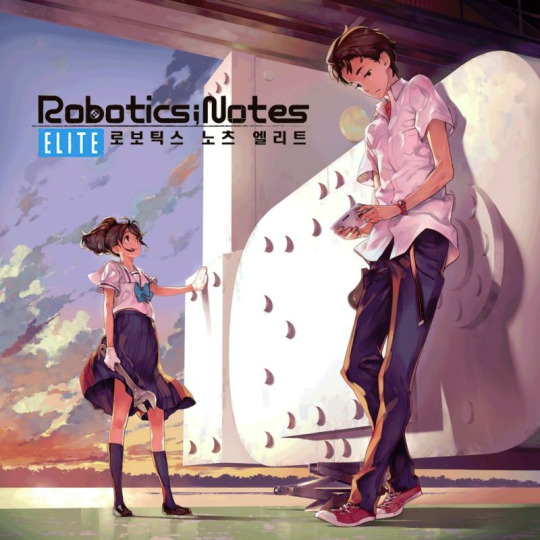
Kaito Yashio is a student of Chuo Tanegashima High, and one of the two members of its Robotics Research Club. The president of the club, Akiho Senomiya, Kaito’s friend since childhood, and little sister of the club’s founder, Misaki Senomiya, is completely committed to completing GunBuild-1, a lifesize recreation of the titular mecha from the extremely popular anime Gunvarrel, and a project the club has been working on since its creation. Unfortunately for Akiho, everything seems determined to see her efforts be in vain. The club gets no funding, and is seen as a laughingstock among the students, its advisor, Mitsuhiko “Mitchie” Nagafukada, is completely irresponsible and rarely does anything of help, and Kaito is completely apathetic to anything that isn’t KillBallad, a mobile fighting game he’s determined to become the top player in the world in. While the club soon manages to gain three new members, namely Subaru Hidaka, an expert in robotics whose knowledge far surpasses Akiho’s, Junna Daitoku, a former member of the karate club, and Kona Furugoori, aka Frau Koujiro, the teenage creator of KillBallad, their personalities are just as difficult: Subaru sees the project as a lost cause, and refuses to help with it without a compromise, Junna is painfully shy and has a fear of robots, and Frau is a complete shut in and social mess, being completely perverted and mostly talking in outdated slang, which keeps most people from even understanding her. Despite all this, Akiho’s unrelenting passion for mechas, and desire to step out of her sister’s shadow, compel her to continue on.
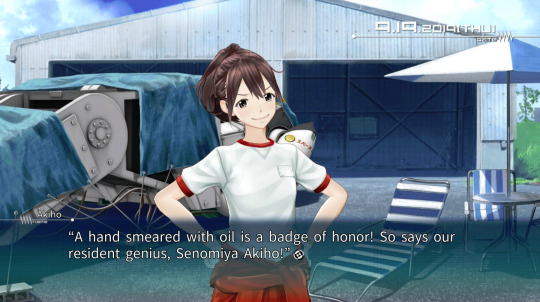
Meanwhile, Kaito one day encounters Airi, an AI that exists within the augmented reality app IRUO, along with a strange AR annotation called the Kimijima Report, authored by Airi’s deceased creator, Kou Kimijima. Within it are warnings of a grand conspiracy that aims to devastate humanity, the details of which are contained in similar reports hidden all over Tanegashima, locked behind “flags” that must be cleared before they become visible. Though at first skeptical, it soon becomes clear to Kaito that the reports contain a disturbing amount of truths, and that he’s become involved in something far larger, and far more dangerous, than he bargained for.

I’ll say it now, the story’s focus on both of these plotlines causes a number of noticeable issues, mainly due to feeling very disconnected from each other. While all of the main cast except Airi are heavily involved in the Robotics Club plot, only Kaito, Airi, and to a much lesser extent Frau are involved in the Kimijima Report plot, in comparison to, say, Steins;Gate and Chaos;Child, which tied its whole cast into their stories much better. In addition, the majority of the focus is on the club, and though always interesting, the reports tend to go rather uneventfully as well. Due to this, the story can feel very slow and meandering if you don’t know just what you’re getting into, much more so than the other entries in the series, which can definitely make it seem unappealing. Additionally, the story is much less standalone than most SciAdv VNs, where the references are often minor. Here, there are some rather significant references to Chaos;Head and, to a lesser extent, Steins;Gate, to the point of outright spoilers in a few cases, meaning going through those beforehand is heavily recommended, which is especially annoying when Chaos;Head still has no official translation, and only a fan translation for the incomplete PC version.
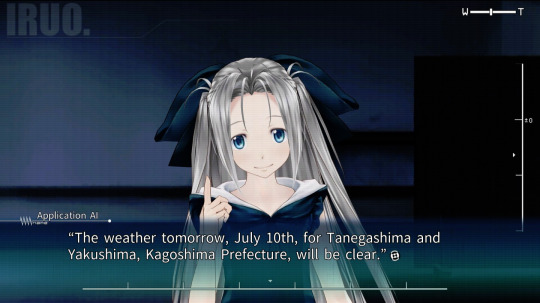
Despite all of this, both plotlines are actually quite compelling, once you get used to the game’s pacing. Robotics;Notes’ biggest strength is its absolutely great cast of characters. Everyone in the main cast is very likeable, distinctive, and well developed across the story, and have good dynamics with each other, with Kaito and Akiho’s interactions being some of the biggest highlights of the game, with the end result making everyone feel significant in their own ways, and truly feeling like a unified group, something Chaos;Head and even Steins;Gate struggled with at times. Kaito, who initially comes off as a very motivationless character, has a good amount of backstory and a constant, if subtle, arc throughout the game that makes him properly fleshed out. Subaru, who’d normally just be the token other guy, is a prominent and likeable character in his own right, having a very important role in Gunbuild’s construction, while Frau, who initially just comes off as comic relief, has many great moments throughout the story, with her focus chapter in particular being one of the best in the game. Even Airi has quite a bit more to her than it may seem. The cast is definitely a worthy successor to the cast of Steins;Gate, even more so than Chaos;Child’s, I would say.

The cast also heavily ties into one of the main themes of the game, namely dreams, the harsh difficulties and compromises one faces in pursuing their dreams, and how losing one can change a person. All of them face this, with varying amounts of focus, and it’s a theme furthered with the prominence of robots throughout the game, both the idealized kind found in mecha anime, and the real, practical robots of the real world. There’s an almost exhaustive amount of detail put into the construction and function of real robots, which makes for some interesting, if sometimes long winded, discussions throughout the game, in true SciAdv fashion.
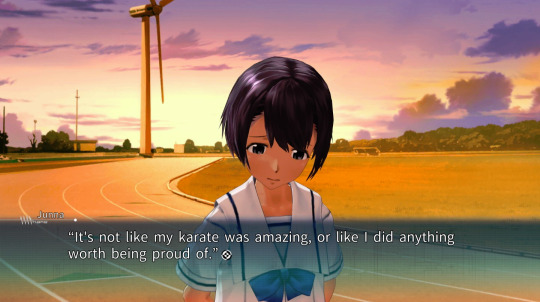
While the story is mainly told through Kaito’s perspective, it switches fairly often to other characters, most often Akiho. While the rest of the series except for Steins;Gate does this as well, it’s notable here for giving almost every character, even the supporting cast, at least one scene from their perspective, often focused on their own personal dilemmas, or flashbacks involving Misaki. These perspective switches make a nice change of pace, and definitely help flesh out the characters even further. On the subject of the supporting cast, while most other entries either have supporting casts that are very inconsequential, such as in Chaos;Child, or almost nonexistent, such as in Steins;Gate, Robotics;Notes, on the other hand, has a much more prominent and fleshed out supporting cast. From Mizuki Irei, the harsh and snarky convenience store employee, and info broker to Kaito, to Tetsuharu Fujita, the grumpy but fair “Robot Doctor”, to Mitchie, the horribly unreliable, yet entertaining club advisor, they certainly leave much more of a mark than usual. The most interesting of all, though, is a 20 year old Nae Tennouji, originally a very minor character in Steins;Gate. She has an almost surprising amount of prominence throughout the game, and even has her own ending, if a very short one.

Compared to most other entries in the series, Robotics;Notes definitely carries a much lighter tone. Tanegashima makes for a very relaxed setting, and as mentioned, there aren’t quite as many big events as one might expect. The characters are generally pretty lighthearted in personality as well, up to Kaito not being nearly as unlikeable to start off as other SciAdv protagonists. However, the tone works quite well, and helps slowly endear the characters to you even early on. And while it’s not quite as messed up as, say, Chaos;Head, it’s got more than a few disturbing elements and scenes of its own. Ultimately, it has the same “feel” as the rest of the series, and when it wants to be intense, suspenseful, sad, or whatever else, it absolutely works, especially from chapter 7 onward.
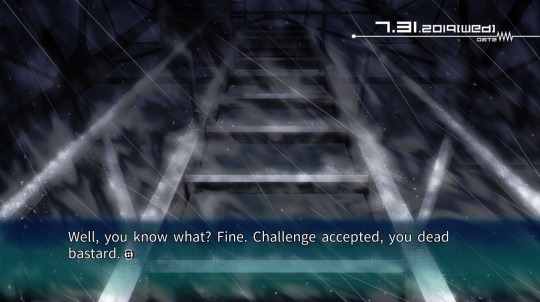
As far as “gameplay” goes, there’s a surprisingly large amount of interactivity available. At most moments during the story, Kaito can pull out his tablet and access its various apps. Most prominently, there’s Twipo, an obvious lawyer friendly version of Twitter, where Kaito can look at tweets from the Robotics Club, its associates, and even random accounts commenting on current events, with Kaito having the option to reply to those of the Robotics Club. There’s also IRUO, the augmented reality app, which lets the player look around the area and scan geotags, which contain small profiles for characters, or details for locations or objects. IRUO is also used along with a map app to search for the Kimijima Reports, letting you travel to various different locations on Tanegashima to search. It’s a neat concept, but the icons for the reports are so small, and so many locations tend to be available at one time, that finding them can often just be annoying. There’s also, of all things, the otherwise story reliant KillBallad matches, where you have to successfully input a string of buttons, the length of which varies depending on the opponent’s skill, within a time limit in order to win. Most of the time it doesn’t matter, but there are achievements and even story sequences reliant on winning or losing certain matches. All in all, these make for nice occasional changes of pace, but it’s still a visual novel in the end.
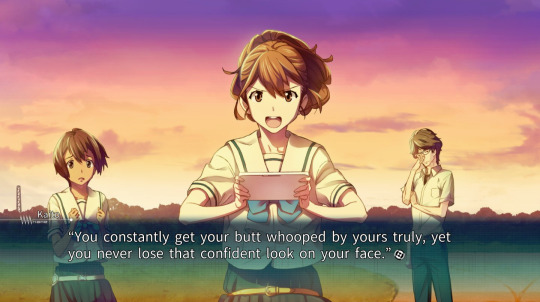
Visually, Robotics;Notes is actually quite impressive. As can be seen in the screenshots, instead of sprites, 3D character models are used instead in normal scenes, and having played Virtue’s Last Reward and Zero Time Dilemma well before this, I was more than a bit wary of them before release. Thankfully, compared to the cheap models of those two games, they’re much, much better. They’re actually very expressive, and have some great animations that give each character a lot of life. The backgrounds are also quite well done, and Tanegashima definitely makes for a unique and atmospheric setting. As usual for visual novels, there’s also CGs throughout the game, done in a different, but still appealing and well drawn style. Finally, in one of the biggest additions to Elite compared to the original version, occasionally, clips from the anime adaptation is used, mostly to better demonstrate details that were only narration originally, as far as I can tell. This blend of 3D models, CGs, and animation is a bit bizarre at first, but it works surprisingly well, and makes for one of the most visually appealing entries in the series.
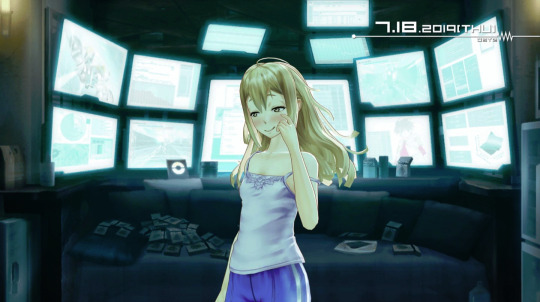
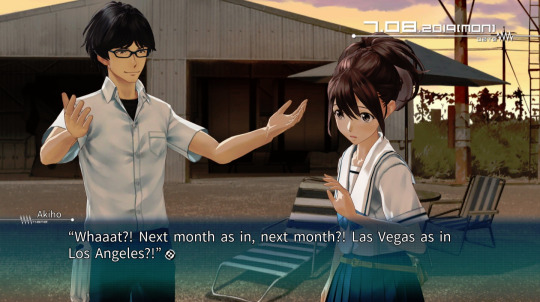
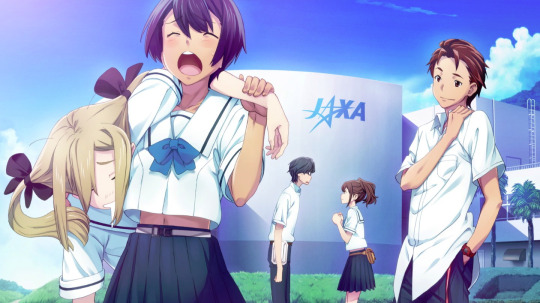

As far as sound goes, Takeshi Abo is once again the composer, and once again puts out a very good soundtrack, which further captures and enhances the atmosphere. The soundtrack in general is definitely much lighter and peaceful than usual, but actually has more tracks than most of the SciAdv soundtracks, allowing it to cover many other moods as well. From the very relaxed Winds of Tangegashima, to the mysterious Uchugaoka Park, to the nostalgic Memories with Big Sis, and especially the beautiful title screen theme, Robotics Notes -2nd theme-, there’s a lot of great songs to be found. The voice acting is also very good, and the characters wouldn’t work nearly as well without it, with Ryohei Kimura as Kaito, Yoshino Nanjo as Akiho, Kaori Nazuka as Frau, and Sora Tokui as Junna especially sticking out to me.
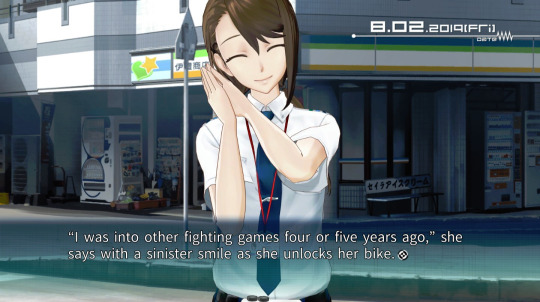
It’s worth noting that Robotics;Notes is on the longer side when it comes to SciAdv, much like Chaos;Child. It’s hardly Fate/Stay Night, but it’ll take some time to get through. It also has a very, very weird and annoying ending system. Whereas in other titles, endings are, just that, actual endings you can diverge into somewhere in the story, Robotics;Notes’ endings are actually just regular chapters that are part of the main story, which just happen to focus on different parts of the cast. The divergence happens in chapter 5, and depends on your replies to said characters on Twipo in both that chapter and the preceding one, with you instead going to the short Nae ending if you don’t fulfill the requirements for any of them. While Steins;Gate had a similar system, and was annoying in of itself, Robotics;Notes takes it to another level by making all but the Nae ending mandatory, though said ending has some points that make it worth seeing regardless, and occurring in a specific chronological order, despite allowing you to get the endings nonlinearly, meaning you could accidentally skip from chapter 5 to chapter 8. The system overall is just unneeded, and following a guide, such as the one by the aforementioned Committee of Zero, is highly recommended.
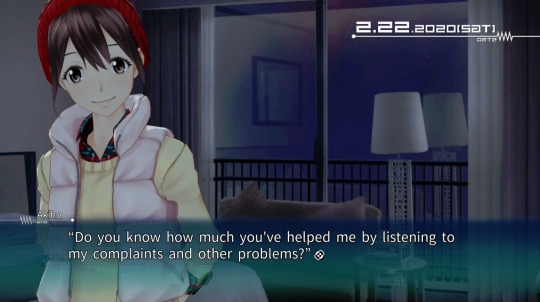
In the end, would I recommend Robotics;Notes? To a SciAdv fan, absolutely. To someone who isn’t, well, I already explained the problems there. I can’t say its one of my favorites among the series, but by itself, it’s still something I enjoyed a lot. Despite the issues it does have, its very well done cast, visuals, sound, and overall story make it a memorable and emotional experience in its own right. Now, with yet another long VN review out of the way, I anxiously await the Committee of Zero patch for Robotics;Notes DaSH, to finally finish off my SciAdv journey, for the foreseeable future, at least. Till next time. -Scout
31 notes
·
View notes
Text
Alright, so I’m bad at Tumblr, and though I wanted to just reblog the original post from @strawberrycreampiefluff and put most of it under a cut or perhaps find a way to trim it, I couldn’t find a way to make it work. So, we’re starting a new thread. Here’s the link the other one if anyone reading hasn’t been following the discussion and want to catch up: https://strawberrycreampiefluff.tumblr.com/post/625063196626223104/what-do-you-think-of-this-whole-ppl-shipping
Anyhow, since we discussed this beforehand, I’ll start from the beginning, only working with the storytelling elements from the series, and I’ll leave out the latter part of the post regarding moralizing (which I mostly agree with anyway, so it’s no loss to me).
“I was trying to convey that considering the methods of storywriting and telling, it would break the “pattern” Rumiko Takashi built up and lowering the impact of Sessh character growth he would later experience. A father-daughter bond is not inferior to a romantic bond, but it would seem out of place, to have both his father and brother form a romantic relationship with a human and then Sessh breaking that pattern by introducing a new kind of relationship-dynamic - when he is the most crucial character in the series when it comes to demon-human relations.”
I’m still quite unclear HOW the impact of Sesshomaru’s character growth is necessarily lowered from not having a romantic bond with a human. Why is the continuation of this pattern so important, in your view, to the character’s development? From my perspective, introducing a new relationship dynamic into and breaking patterns is actually a good thing in stories - It’s a great way to add variety and a different point of view to a narrative. Having characters take a pattern in a different, unique direction can add meaning in a way the reader couldn’t see coming, give the story unexpected dimension.
And you’ve already said that you and other shippers like yourself don’t see anything romantic while Rin is still a child in the original series, so that is effectively what happened. Since we agree that the relationship wasn’t actually romantic within the context of the original Inuyasha series, Sesshomaru took a love of a human in an entirely different direction than his father or his brother did. Which conveys complexity in how youkai can relate to humans that wasn’t in the established pattern. As a reader, I find that kind of thing fun and engaging, though you may disagree.
“A father-daughter relationship would still put Sessh in a superior position to Rin (as the father), not adding a lot to his character development other than him caring for one other human being.”
I have to wince here, because while yes, technically Sesshomaru is in a superior position to Rin in a father-daughter relationship, the implication here is that this can be compared to the sense of superiority he had over humans as a whole that you referenced earlier. Is a parent-child relationship really comparable to a racist outlook? I feel like these two things are quite unrelated, having two ENTIRELY different connotations from the word “superior”. One is an entirely natural superior position, using one’s greater experience, knowledge, and ability to facilitate the growth and guidance of someone still on their way up. The other is a wholly unnatural and malicious disregard for a person based on superficial features. Sesshomaru’s superior attitude toward humans before he met Rin was not based on a paternalistic concern, but complete disgust and the notion that they were entirely unworthy of consideration. The two connotations of “superior” here are just not analogous in the greater narrative.
“In a romantic relationship, both partners should be equals (anything other is unacceptable), for this to happen Sessh would’ve had to lower himself (his pride) to Rins level, since he was the one with the big ego and humans were regarded as one of the lower creatures of the food chain.”
Again, I think it is entirely possible for Sesshomaru to learn not to regard humans as “lower on the food chain” through a relationship that ISN’T romance, but that aside, this whole notion brings up a question: why didn’t Rumiko Takahashi write Rin into the story as a young adult? We’ve already discussed how romantic implications to the relationship couldn’t exist while she’s still a child in the series, and why Sesshomaru and Rin are definitely NOT equal during the series. So if it was so important for Sesshomaru to be otherwise equal to Rin so he can lower his pride and truly consider her such, why was Rin not written as a fully autonomous adult so we could cut to the chase? It seems that if what you’re describing was really Rumiko Takahashi’s intent, it would have been a lot easier if the girl was already grown up. At the very least, our dear author could have ended the series when Rin was an appropriate age to actually make the point instead of leaving it hanging.
“Doing the exact same thing he criticized his father for, which for him would’ve been humiliating in the beginning of the series. The sequel (if you regard it as canon) goes even farther, making him create his own half demons - the very reason he hated his brother in the first place. His mother even said he becomes like his father in the strangest ways - and the only “strange” thing we know about his father was his romantic relationship with Izayoi.”
Since English isn’t your first language, I’m guessing you’re just mistaken in the map of this sentence, but the word “strange” here is referring to Sesshomaru’s behavior in relation to his father’s. What is strange is how Sesshomaru is like his father, not his father’s ways. This actually makes the opposite point - it seems to refer to the ways in which Sesshomaru is behaving as odd, maybe in relation to a pattern his father fit into.
“That’s why I think it wouldn’t fall apart if we draw the parallel in a wider context as you say, because other characters didn’t have the same starting point as Sessh. I very much agree with you, that Inuyasha’s platonic bonds would also count as a dog forming close bonds with humans, but in Inuyasha’s or Shippou’s case, they didn’t need the same character development like Sessh, since they had a different attitude towards humans or “lesser-beings” in the first place (Inuyasha was even past the stage of lowering himself, also out of romantic reasons btw, since he was ready to become human for Kikyo).”
I’m curious as to how the parallel and pattern matter if it’s null and void because Inuyasha and the other characters we talked about have different character arcs. Of course they aren’t starting from the same place as Sesshomaru, characters never do. They’re varied and diverse because it would be boring as tar to write them all going through the same issues. My point about the parallel was that even if it could be said that there’s some similarity in how dog YOUKAI form bonds with humans to actual DOGS, it’s not really a good parallel, because there are other “species” of youkai much less friendly with humans doing it too. I’m having trouble understanding what this argument has to do with that.
In reference to the above, I agree, the example characters you cited didn’t have the same level of dismissive racism as Sesshomaru did (I say “same level” because Shippou does carry a bit of prejudice, even as a small child), but when that’s apparent, why is the pattern even relevant? Since the characters aren’t set to all learn the same lesson, their relationships shouldn’t really resemble each other’s in the long run either, should they? Writers use relationships as tools for character development, and they usually want to use the right tool for the right job. Maybe romantic love with a human was right for Inuyasha because he had issues with vulnerability and reconciling his half-heritage. What if SESSHOMARU benefited more as a character from an unconditional bond (free from the conditions of sexual/romantic attraction) to demonstrate to him how even the weakest creature is incomprehensibly valuable for reasons impossible to articulate, and they are worth using his incredible level of “superior” power to protect and defend them? It’s a different kind of humbling oneself than what you were talking about, but I think it’s just as meaningful, and it fits Sesshomaru’s character development neatly into the the original text. It doesn’t require Sunrise make a sequel more than a decade later to wrap up the character development that Rumiko Takahashi meant to do when Rin grew up even though she could have just written her in as an adult in the first place.
“But Rin will obviously not always stay 8/11 years old, she will grow into her own person and become a woman (while living apart from Sessh), creating a completely different power dynamic with Sessh. One that would still be an imbalance, but much different than when she was a child.”
As far as the narrative was concerned, Rin COULD very well have stayed a child forever, though. She was written as a character in a story. When the story is done, so are the characters. You’ve said before and here that Inuyasha is just fiction, and it is, but accepting that means accepting that Rin doesn’t grow up without some prompting. She doesn’t age but through the hand of a creator, fanfiction authors or Sunrise. When you say she’s not going to stay 8-11 forever, what you mean is that actual humans who experience actual time are not satisfied with her age as it stood when the story ended, and actively impose time upon her.
And since applying time to a fictional character is something that has to be intentional, so too do the conditions you mention to create the perfect environment for the ship. The different dynamic that isn’t father-daughter, but still a little bit of not-weird power imbalance. The “lowering” of Sesshomaru’s ego in that specific romantic way (that I’m still not sure I understand, but we’ll go with it). The way in which the romance is developed without either character realizing it so that Sesshomaru can’t be accused of using the power imbalance to manipulate a girl he’s had authority over since she was eight. Returning to what catalyzed the change in Sesshomaru in the first place while carefully treading around the fact that it was built upon an unconditional relationship that now suddenly has conditions on it. That’s a lot of mental legwork to do, which is fine, because that’s part of creative expression. But you have to acknowledge that none of this would be necessary if the pairing were “obvious”.
It certainly wasn’t very obvious to some of us. We came to a very different conclusion, saw everything a bit differently. Now we’re being punished for having a less popular interpretation of this relationship, shut down by SUNRISE and told that we don’t get to have that interpretation, because they’re considered an authority on what is canon in Inuyasha, and they’re taking sides to squeeze more money out of the Inuyasha franchise with a next-gen sequel. It doesn’t seem to matter that Sunrise was never really very good at telling Inuyasha stories, or that next-gen sequels never seem to be any good for lack of stakes and boring plots.
Sunrise’s interpretation is still considered to be more “valid” than ours. And that really hurts. So, if you found yourself wondering why there’s so much vitriol coming from the anti camp, it’s a combination of this, and the fact that they don’t really have the option of avoiding the content they don’t like anymore. It’s kind of EVERYWHERE now.
So, there we are. I don’t want to give the impression from the above that I’m trying to tear apart your arguments to somehow discredit the pairing. Shippers gonna ship, whether it makes sense to me or not. But I did want to highlight how any of the things you bring up can very well be interpreted entirely differently.
Hope you’re doing well, and you did well on that exam. :)
#inuyasha#anti sessrin#iy discourse#sesshomaru#rin (inuyasha)#@strawberrycreampiefluff#apologies for the technical difficulties#i'm tumblr illiterate
66 notes
·
View notes
Text
Diamond Fusions Headcannons
First there’s the question of whether they ever fused at all in the past, since they only do it for fighting on homeworld, and the Diamonds would probably have been considered too powerful to “need” it
If that is the case, and the others eventually become cool with it in the present day (which might take until Steven reaches adulthood), they will probably really come to regret that they never fused with Pink while she was still alive and that they basically have only their own attitudes to blame for it.
Then again though the chances are low it’s not wholly impossible since they’re all the same gem type. Perhaps in the context of combat training (in which case there might be a situation where Steven asks them what their fusions are like, personality wise, which they probably never considered)
Which is in itself an interesting question - were they ever taught to fight?
One the one hand they would probably have been considered way too important to get on the front lines and have legions of soldiers to do the fighting for them - on the other hand they’re expected to have and project power
They DO seem to make the choice to toast the rebels themselves when they land on Earth without much of an entourage since they’re only expecting a small remnant force and have a personal vengeance thing going on. Same thing when all three of them blasted the earth.
When Blue and Yellow got into a fight with the CGs, you get a sense that while they’re equal in durability and raw power, Yellow has a lot more actual combat experience. They don’t land any actual damage on Blue apart from messing up her hairdo, but they did briefly have her somewhat cornered, you get the sense that she’s mostly used to just disciplining her underlings and that her lasers and pathokinetic aura usually do the trick there; Meanwhile Yellow punches her way out of the ship with her bare hands and proceeds to knock off half the opposition within the first minute. It’s amazing that our heroes were able to hold out as long as they did, but there’s a strong implication that they would have been toast if it weren’t for Steven’s intervention.
And of course it makes sense given that Yellow seems to be in charge of the conquering and has been for tens of thousands of years, you bet there were a few times were she would have been forced to defend herself, or at least want to be ready for it in case.
As for White, I wouldn’t peg her too far above Blue’s level in terms of skill, she has the (thought/motion controlled) mecha pull off a couple fancy kicks so she’s probably not doing it the first time, but they get her with relative ease once they form obsidian. Granted, she was probably fairly confident that they weren’t an actual threat since she could always just mind control them.
Did they have some attendants doing that, or did White teach them herself? I suppose by the time Pink came around, she would’ve left it to Yellow and Blue to prepare her. And, if fight training was a thing, that would come with the painfully ironic implication that Pink used everything they taught her against them once she rebelled.
So, back to fusions.
General Thoughts
I think that Blue and Yellow could already do it if they wished to, not so sure with the rest - but in any case I don’t expect any of them to hold much better than early-series Opal (perhaps slightly better than that for Yellow and Blue) because for all that they do care about each other they’re a dysfunctional bunch and have very different approaches to things.
Any fusions involving Steven would hold slightly better because he’s just good at it. One wonders who’d fuse with him first, Blue or Yellow. He generally tends to get along best with Blue (She’s usually the one carrying him around, the first he wins over and the first with whom he tries to talk about his own life in ways unrelated to accomplishing his mission) but she’s a lot more squeamish and proper and seemed akinda repulsed by the whole fusion thing, like there’s a long way between decriminalizing it and being willing to do try it. - Out of the three Yellow seems to be the most no-nonsense, experimental one,judging by the peace sign and so on.
A lot of ppl draw the fusions with extra eyes etc which would follow the general logic of having ppl with diferences in their pvs have four eyes etc. but then again they’re the same gem type so they might just come out larger but humanoid. Do the various Diamonds ‘count’ as different enough? I guess we won’t know unless we see it. though I think even the crew decides this more based on what looks the coolest.
If their markings around the eyes don’t combine somehow in a cool fashion, what is even the point.
Also, remember in the early seasons where Pearl and Amethyst would tend to clash with Sugilite and Sardonyx respectively, and be lowkey intimidated by them and both kinda provided an insight in how Pearl and Amethyst would act if they were more confident and/or in charge?
Pretty sure that at least early on or pre-Steven, the same would be going on whenever White fused with one of the younger Diamonds. (if not more so - while Garnet just happened to be the most powerful one, was upset when that got in the way of her friendships and is self-aware about her limitations, White is legit terrifying. Even when Steven wins her over she just goes straight to “creepy cute”, she doesn’t know how not to be. ) So basically Blue and Pink would be fundamentally creeped out by White’s and Yellow’s fusion, and likewise Yellow and Pink would like not to have to deal with White’s and Blue’s fusion.
White alone is at least “polite crazy” and prefers to leave the threats implied and “break them by talking” if she can, but a fusion with Blue or Yellow in the mix wouldn’t be nearly as distant so the crazy would be closer to the surface - besides you’d probably see more of Blue, Yellow and Pink’s negative traits manifested with less of the positive ones present because, after all, White is the one who brought them up to be villains rather than heroes.
This could probably be softened with some character development once White actually gets to a point where the other two can trust her again and not be on edge around her, and at that point she’d perhaps be adding something more like a playful whimsy and a bit more animated surface-level expressiveness than Blue and Yellow have on their own.
Individual Fusions
Yellow and Blue: I quite like that idea someone put forth that they might have an edgy mid 2000s goth thing going on - (in canonland a lot of the fusions have a ‘theme’) but if they go for ‘elegant’ instead it would probably be in more a modern-artsy than a fantasyesque way. One wonders how the round vs blocky shapes would be blended like it would have to be a midways point between them but also not look too much like White. (who might be a bit miffed if this fusion winds up taller than her)
With these two there’s some potential that they might complement each other in a positive way and sort of balance out some of their shortcomings like they would patient like Blue but responsible like Yellow, but still probably rather intense as both of them are in their own ways like the fusion would probably embody the sides of them that they show when they’re in private together without either of their facades, but also their dynamic of supporting each other through adversity, so they would probably be someone you can count on despite their sour demeanor.
White and Yellow: Cersei-Lannister esque metal dress. Hair is basically like White’s but shorter and spikier so it resembles are crown more than a star. All of Yellow’s pragmatic utilitarianism and harshness but not much of her consideration. As unreadable of White but with a hard frown instead of a smile. Big operatic voice.
White and Blue: Maximum Winter Witch aesthetic. Or possibly “The Fair Folk” instead. Probably rather introverted and somewhat apathetic but capricious if angered and relatively eerie/inhuman looking.
White and Pink: There’s just no way this wouldn’t end in a Sugilite or Malachite level debacle, there’s just way too many knots in that particular relationship. Might not even get her own voice. If this ever happened, they tried once or twice, it went south, and Pink got all the blame. Would hold together well enough but not in a good way. Looks and personality wise, the fusion would probably be like the ultimate bratty gremlin.
White and Steven: probably also gremlin-like but in a positive, playful fashion. I don’t think the outfit would be much less frilly, if anything you’d probably see a lot of Steven’s “fabulous” side surfacing here. Perhaps a doll-like theme?
Blue and Pink: Adorable as fuck and probably somewhat dreamy. Somewhere between princess classic and alice in wonderland. Probably holds harmonously enough while they’re doing Shenanigans, but prone to unfusing quite abruptly and inelegantly whenever Pink chooses to do something that would not jive with Blue “proper” sensibilities. (”Why don’t we sneak out of the arena like this-” “PIIINK”)
Blue and Steven: At this point so much character developement would need to have happened that it’s hard to guess where things might go. I mean could you picture Blue in pants? Would be nothing like the 1.0 version apart from the color sheme, probably on the sweet and reserved side and would reflect Steven’s influence a lot. Maybe they would have an “eerie psychic child” thing going on? Like if you put Blue and Steven together the result would probably have rather strong but somewhat volatile psychic abilities that would, to them, feel sigificantly different from their usual ones.
Yellow and Pink: Drawing a bit of a blank here since their aesthetics and approaches to things are so different. I guess you could say (and that correlates with other orange or red gems we have seen) that they would be somewhat fierce and impassioned, but I think they too might get some complementarity going on, if the result was more focussed than pink but not as uptight as yellow.
Yellow and Steven: Hm. Perhaps this would look like something out of a sci-fi comic/ video game, since Steven has a bit of a taste for that. He’s never really done serious except in momentary, over-the-top lapses so heaven knows what style of speaking that fusion would end up with. That said though it’s subtle Yellow is the one out of the bunch who does have a sorta funny, dorky side to her somewhere, and another commonality is that Yellow sure tends to look out for those around her (though not so much those outside her inner circle) - Like perhaps you’d get some of that, but their way of going about things would include some of Yellow’s more pragmatic approach.
10 notes
·
View notes
Photo
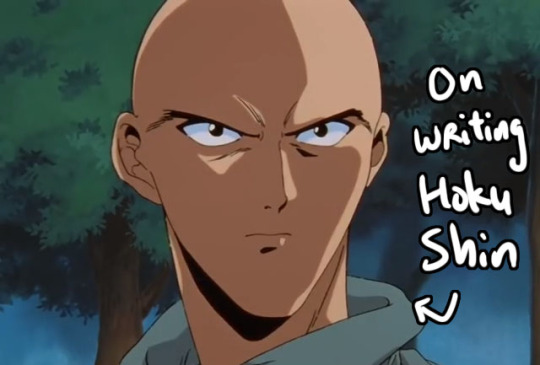
On writing Hokushin
(unrelated: WOW I just realized I can do headings in tumblr! WOw!!!)
I’m on a roll avoiding other work I should be doing lolll! Lately I’ve been super fortunate to have some great conversations with multiple lovely people about characterization of Hokushin. To probably no one’s surprise, I already think an embarrassingly lot about this and try to convey it in my fanworks, but I actually haven’t really sat down and articulated in depth. Shocking, I know. So here are some cleaned up/slightly more coherently organized version of thoughts!
Below the cut I basically ramble for a long time about understanding Hokushin's character with cultural/historical background and his relationship with Yusuke (and by extension Raizen). And some misc other stuff. I tried to break it out by topic, but a lot of it overlaps. One thing I don't really get into here is specific aspects of Mahayana (Zen) Buddhism, but it has an important underlying relationship with a lot of what l talk about below, and forms a significant part of Raizen and therefore Hokushin's narrative, how their characters are portrayed and framed, aaaand this is already really long.
With all that in mind, this is one person’s interpretation! I’m no expert, I mostly just read a lot of stuff when I get obsessed with it (usually for storytelling/comics research, and then forget everything soon after lol). In any case, it'd be boring if my ideas on Hokushin were the only ones that exist, and the point of fanworks is to create for personal enjoyment/fulfillment, so please make of it what you will! All I hope is that this was at least somewhat interesting/informative and helps give people more material and more love for Hokushin =D
The loyal retainer archetype

Hokushin's character is very strongly tied to the perceived classic Japanese archetype of the loyal servant/retainer and samurai (bushi/warrior class) ideals. They come with a very distinct paradigm and set of principles. Here’s a simplified summary.
Purpose, honour and thereby happiness comes from selfless loyalty and servitude. The fulfillment of your existence is to serve the will of your master.
The ideal/collective whole is prioritized above an (your) individual existence. There is a greater goal that you are merely one small aspect of, and you may not even expect to understand it.
Death is not necessarily perceived as a worst-case scenario, and can be viewed as the most honourable alternative to violating your own or someone else's principles, particularly that of your master. And in some cases, it may even not be an alternative. Death is not an end, but a means to an end usually to support the beliefs held in the previous two points.
We can reference the 8 virtues of bushido - the way of the warrior, sometimes called the samurai code. Now, bear in mind nobody necessarily went around going “I’m a samurai, and this is the code I follow.” This is a list formalized in the late 19th century by writer Nitobe Inazo to explain a concept of bushido and Japanese culture for a Western audience, and then it basically got absorbed back into Japan. Thus, bushido is a pretty heavily romanticized thing, and... anyway that’s beyond the scope of this post lol. The virtues are:
Righteousness (also rendered rectitude, justice)
Courage
Benevolence/mercy
Politeness
Honesty/sincerity
Honour
Duty/Loyalty
Character/self-control
BASICALLY A HOKUSHIN RECIPE, AMIRITE?? There are also particular aesthetic sensibilities to the execution of this archetype partly based on how Japanese history and culture evolved. Bearing and sensitivity matters, more is said in what is not said, there’s stoicism and elegance and refinement and poetry etc. Mono no aware and transience of life and all that stuff.
Essentially, even if such a character disagrees fundamentally with their master's reasoning, it's not unusual for a "true" servant to still abandon their family or their lovers and follow or even precede their master to death in order to uphold their master’s principles.
In the series, Hokushin says that he doesn't understand the king's reasons for his self-imposed abstinence, but that he still supports the king’s will. Later in the arc, he demonstrates the truth of his statement when he obviously doesn't agree with Yusuke's outrageous tactics regarding the future of their kingdom and the entire Demon World, but upholds it regardless. (As I noted in One and a Half Revolutions, the most "disobedient” Hokushin gets is when he plots strategy with the other monks for what they should do if they end up fighting each other during the tournament, and Yusuke is like YO KNOCK IT OFF NO THROWING FIGHTS. AND ESPECIALLY NOT TO MAKE ME EMPEROR. And Hokushin’s like, well you said you’re not our king anymore, so we don’t have to follow you and can do as we wish. And what we wish to do is make you Emperor. So what’s your issue. And Yusuke is like THAT’S NOT WHAT I MEANT)
This archetype is also NOTORIOUS for assuming a huge burden of responsibility and/or shame on behalf of their master, often in secret, for maximum service/honour value (and narrative/dramatic impact). The legendary Ako incident (the 47 ronin) is a famous historical example.
This intense commitment can be tricky to depict because you have to finely balance outward stoicism and emotional resonance, and you also want to temper things to make a character more nuanced and not just a flat stereotype - e.g., a "you say jump, I jump" personality or have readers going "omg why is this character so spineless/stupid", ridiculous levels of melodrama, etc. You still want people to be able to empathize with the character and to really feel for them when they make decisions that may otherwise seem extreme or incomprehensible. (Although in many ways there's an Eastern/Western philosophical difference in the perception and understanding of this. A simple modern example that comes to mind is in Pacific Rim, when Raleigh asks Mako why she's so obedient to Pentecost and she replies (paraphrased from memory), "It's not obedience. It's respect.")
The Hokushin decision-making flowchart
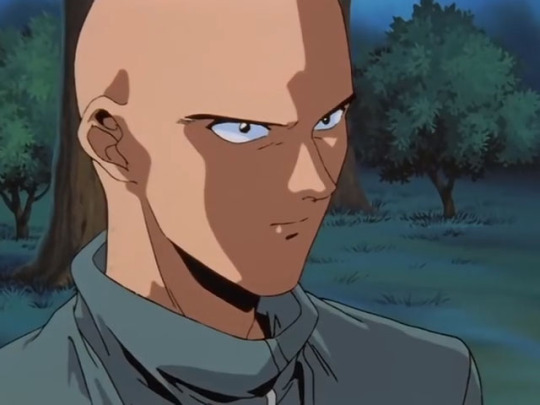
I use this very rough mental outline as a general guide if I’m struggling to decide whether or not Hokushin would do something significant. Bearing in mind interesting opportunities are usually not black and white, so “yes” and “no” below are usually more like, “yeah pretty much...” or “no, kinda not...” lol
Is it in accordance with his values? * If yes: go for it. * If no:
Is it in accordance with the will/principles of his master (Raizen, Yusuke, or whomever he’s committed to serve)? * If yes, go for it. * If no:
Does it ultimately aid the endgoals/ideals of his master? * If no: forget it. * If yes:
Can any negative consequences be minimized to affecting Hokushin only or mostly (e.g., punishment or humiliation or capture or whatever) with little to no long-term effects for his master? * If yes: DO IT!!! * If no: FIGURE SOMETHING OUT TO MAKE THIS ANSWER YES!!!!
Situations of deceit must be handled carefully, especially as honour is a major element of this archetype. The above flowchart can sometimes help... That said, deceit can be particularly challenging to contrive within the master and servant relationship. While we don't see Raizen and Hokushin directly interacting in the series, there's extremely strong implied trust between them. We can see this from how they speak of each other to other characters, namely Yusuke. We can also extrapolate aspects of their relationship from how Yusuke and Hokushin interact, because it's repeatedly emphasized that Yusuke and Raizen are quite similar fundamentally, and Hokushin clearly assumes Yusuke will succeed Raizen.
Yusuke and Hokushin: the initial meeting
In their first meeting, Yusuke’s absolutely furious at being misled by Hokushin. The beautiful thing about the setup of this deceit is how it:
Allows us to see the values and personalities of both characters.
Enables Yusuke and Hokushin to evaluate each other.
Establishes and enhances the dynamics of their relationship.
The above lies in Yusuke’s reaction to a particular piece of information being withheld, and how Hokushin handles the situation after being called out. Remember:
Lying is generally not in line with the loyal retainer/Hokushin’s values.
Honesty and straightforwardness are also big for Yusuke.
With point 1, Hokushin deceives not by lying but by leaving out significant information: that he - and potentially by implication, some % of Raizen’s followers - still eats humans so that they don’t get weak and die. His rationale for doing so is that Yusuke, being formerly human and having lots of people close to him who are human, would have a hard time getting past that fact if he learned this on their first meeting, and would not be willing to follow them to the Demon World. Totally reasonable assumption. If Yusuke doesn’t know, he’s more likely to be receptive to joining their kingdom, which protects the interests of his king and the safety of his people. This passes our flowchart with flying colours. (I elaborate on this a bit more in A Song on All Sides.)
However, when Yusuke figures out what happened, point 2 makes this especially problematic for their relationship. We know Yusuke is all about gut feelings and first impressions, so this could’ve been an awful miscalculation on Hokushin’s part.
When I’ve talked about this scene in the past, I usually focus on how in the next few moments Hokushin’s actions allow him to pass Yusuke’s assessment of whether or not he’s trustworthy. But what’s especially great about it is that judgement is actually going both ways. Before Yusuke explains his position, Hokushin’s politeness is his professional courtesy - he’s doing his duty as Raizen’s retainer. As Yusuke speaks in both manga and anime, you can see the exact moment when Hokushin decides Yusuke is a worthy successor. When Yusuke finishes talking, Hokushin’s manner changes - I’d say subtly, but since he essentially gushes about how much Yusuke resembles Raizen for several lines that’s not really true lmao.
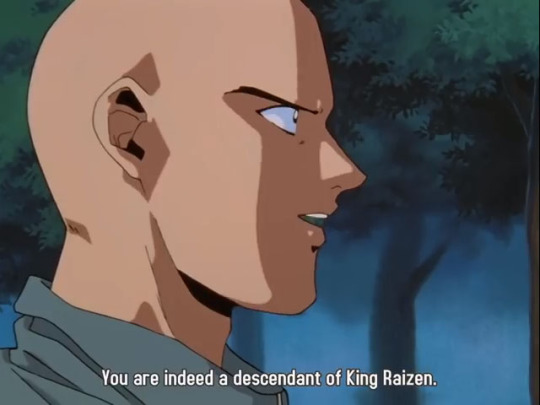
In any case, now that Yusuke’s been deemed worthy, Hokushin steps up immediately to rectify his mistake. And merely admitting an error and explaining himself isn’t gonna cut it in meeting Yusuke’s values - that’s just the bare minimum. A good retainer must know their master so well that they anticipate and go beyond what is merely being requested.
So when Yusuke asks for honesty, not only does Hokushin give that, he takes it one step further with his very succinct, very personal answer to Yusuke’s question of why he follows Raizen. (Paraphrased) "Because King Raizen is like you. Fighting at his side makes me happy. That's everything to me." I can't think of a more perfect reply to mollify, impress and intrigue Yusuke as quickly as that. And in both manga and anime they give Yusuke this little pause as he takes it in - the animation team makes this even more exaggerated than what Togashi did. What I also love is that the dialogue in this scene strongly implies that Hokushin knew how to respond because he knew Raizen so well.
Obviously more stuff happens in the year and a half they spend together in the Makai. Whatever happens, it's clear Yusuke comes to trust Hokushin a lot. He even tells him private, personal things of a nature we don't see him sharing with any other characters. To me, this signals that Hokushin did what a good loyal retainer does, which is to get what makes Yusuke tick and not repeat the same mistake again. (Which is why I always get annoyed at that unnecessary scene they added in the anime version of the tournament... ANYWAYS lol)
Yusuke and Hokushin: the duty of the master
Yusuke starts the series as a solitary delinquent. He despises convention and authority, and dependence on others is a pain. He generally puts on a disaffected attitude, and he often downplays serious emotions with distracting and emotionally shielding tactics like sarcasm. For a character like him, it’s pretty easy to imagine him being all “What the hell, I don’t want to be king! I don’t need a servant!! Go away”. To reject Hokushin’s presence or role totally wouldn’t be out of character.
One of the things I love about the dynamics between Yusuke and Hokushin is that Yusuke clearly gets Hokushin's mindset, and because of it, steps up in order to be able to reciprocate the relationship. In the classic ideal, the existence of the master gives the retainer’s existence purpose. A warrior without a master is considered ronin, which is a very shameful status. The master’s duty is to be(come) worthy of the loyal retainer’s devotion and to recognize the latter’s value and loyalty, often in unspoken ways.
Yusuke doesn’t want to be king - he outright says that he doesn’t think himself smart enough to take care of everyone in his kingdom. But he accepts the responsibility of his role in his relationship with Hokushin.
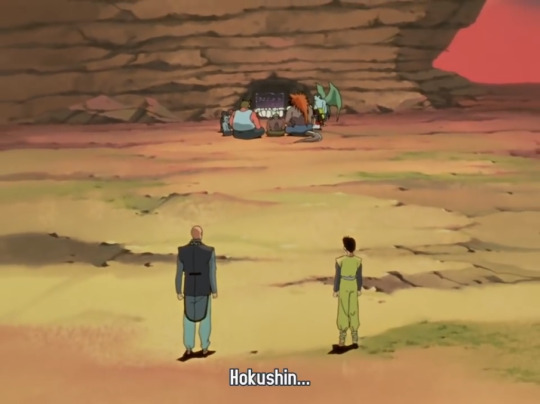
Yusuke’s conversations with Hokushin tend to be discussions that are not only honest but also mature. He takes good opportunities to rely on, and to acknowledge, Hokushin as a retainer without hesitation and without pretending complaint. He actually behaves a lot like a lord in the classic relationship in terms of conveying authority, direction, and intimate concerns (in his Yusuke way lol).
In the meeting with Yomi, Yusuke’s use of the rurimaru is shocking to Hokushin, but when you watch the way the scene is carried off, he bears himself really well in his role. He didn’t carve the rurimaru just because he couldn’t find paper for his lottery names - he specifically chose to do it to the rurimaru, and their value is clearly taken into consideration for his purpose. He also doesn’t crack jokes about having vandalized the gemstones, which, again, would not have been out of character for Yusuke. Instead, he merely presents them exactly the way they should be - as a gift - to ensure he gets Yomi’s attention about his proposal. His body language is dead serious, and he also doesn’t address Hokushin's shocked reactions through the entire scene. He only addresses Yomi. This is totally appropriate form as one ruler to another.
And even after the kingdom is dissolved, Yusuke doesn’t abandon his people, nor shoo Hokushin off. Hokushin is nearly always at his side throughout the tournament. If we look back at the principles of the loyal retainer archetype, one of the things worse than death is to be told by their master "I don't want you for a servant. You’re a useless burden to me". Of course, another aspect of the archetype is that actions speak louder, so the worst would be actually doing things that reinforce/confirm that statement, but it would still be extremely wounding.
A very clear demonstration of the above is when the two of them arrive at the edge of Yomi's territory. The conversation is basically as follows.
Yusuke: OK thanks for guiding me here. You go home now. Dangerous I go alone you know the drill. Hokushin: No, I'm coming with you. You’re my king. It's my duty to protect you. Yusuke: *after a pause* OK fine behave yourself.
with no further argument from Yusuke. No complaints about being called king, no sarcastic remarks about having a tagalong, nothing. Which is not something we usually see or would expect from him. The emotionally downplayed way the entire conversation happens is also very typical. In light of his character and the dynamics of the master-retainer relationship, Yusuke’s behaviour is extremely thoughtful and kind.
Yusuke and Hokushin: the duty of the servant
So Yusuke weighed Hokushin’s response and knew there there was no way Hokushin would have let him go into enemy territory alone. So? It’s not like it’s the first time he’s ever disagreed with someone over how something should be done. So what’s different about this situation, compared to how things might have gone down with any other character who is very close to/invested in Yusuke and has previously confirmed they WOULD be willing to risk death for him - Keiko or Kuwabara, for example?
The difference (aside from the fact that they’re civilians and Hokushin’s a warrior, and Hokushin’s obviously a lot stronger and more likely to survive in most situations) is that Keiko and Kuwabara are Yusuke’s friends. Or more, if you want. But even for other people close to Yusuke who ARE warriors, the biggest difference is that they are not bound in servitude to him. Again, the keyword here is duty - and that concept is huge. Yusuke’s friends want to help him. Hokushin wants to help Yusuke too, but not only that, he MUST help Yusuke. His very existence is an obligation to do so. In some cultures, especially modern ones where the emphasis is on the individual, this can be difficult to appreciate and/or seen as an illogical insanity, but it’s a matter of fact for the loyal retainer. They see themselves as an extension of the will of their master.
Keiko and Kuwabara and any of Yusuke’s other friends mentally would have a normal person pause of “This is ridiculous, stupid Yusuke, you’re crazy!!” and still try to do self-preserving-type things in most instances. To some degree, there’s still an aspect of their decision-making that is not only about Yusuke. They still have a sense that in their relationship with him, they have roles of similar or equal value/weight.
That’s absolutely not true for the loyal retainer. The servant is not equal to the master and the servant firmly believes this because that’s what their existence is defined by. Plus those ingrained principles. For Hokushin, there’d be no normal person pause. We’d zip through that flowchart and he’d be like “You’re crazy. But you’re my king. Guess I’ll die” and like jump into an active volcano or whatever. He would be completely and unhesitatingly willing do something, whether it’s spur-of-the moment or deliberately planned, that would result in death if he thought it’d help safeguard Yusuke/achieve Yusuke’s endgoal. And obviously that's the last thing Yusuke wants.
With this character archetype, this is where a lot of stories end up going for the “and then one of them pretended to let the other person have their way before SURPRISE KNOCKING THE OTHER PERSON UNCONSCIOUS TO PROTECT THEM, and then they went on to do their selfless ‘getting killed in your place’ thing” which I’m super glad Togashi never resorts to. Since all the above builds up to a huge part of what makes the reveal of Yusuke’s gift to Yomi extra effective - Hokushin’s reactions. This is largely why the scene is so comical, because Hokushin’s manner grows more and more freaked out - and entertaining, being in direct contrast to his stoic retainer archetype. Meanwhile, as mentioned previously, Yusuke’s bearing (if not his manner of speaking...) is exactly as a lord in the midst of negotiations would be. (My favourite part is where Hokushin still tries his best to address Yusuke properly as king, before losing it when he finds out Yusuke vandalized the rurimaru. In the manga, his expressions are beyond hilarious. In the anime, his scramble to recover the appropriate body language is really cute. His constantly shifting expressions throughout the background of this entire episode are great too. I always really like the faces in the episodes directed by Enomoto Akihiro.)
Finally, food.
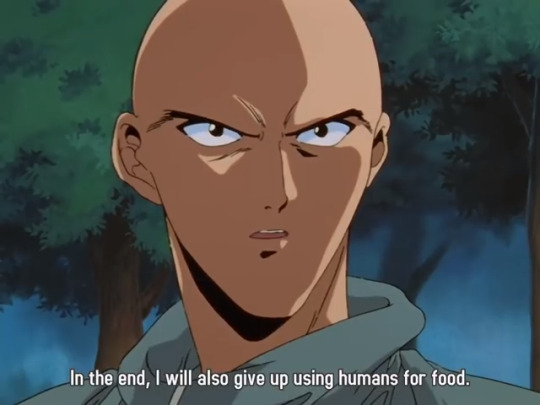
One more challenge with Hokushin is his diet. He needs to eat humans or will suffer from the same malnutrition that is sapping Raizen’s energy and killing him. At the same time, he’s depicted as a character of integrity and compassion, so I always feel obligated to think carefully about the topic of procuring a human for food. I take a stab at an idea in the prequel Mirror Most Dark. However, the approach isn’t very feasible for the time period of actual Yu Yu Hakusho.
From a writing perspective, the problem is one of scale. It goes beyond Hokushin as an individual to the situation of a reliable/sustainable food source in Raizen’s kingdom for the % of Raizen’s population that needs it. And whatever it is, Hokushin is likely highly involved as the main instrument of Raizen’s will. I have some ideas but haven’t really cared to flesh (haha) them out to a point that’s satisfactory to me yet, so it’s only barely touched on in One and a Half Revolutions. This is far less of an issue after the series ends, when you can easily come up with ideas on how they’re looking for or have found alternatives, but during the time period of the actual series your options are more restricted.
I have lots more stuff around these themes and ideas planned for North Bound too I JUST NEED TO GET AROUND TO DRAWING THEM
In conclusion, thank you for reading this mess lmao.
#yu yu hakusho#hokushin#fanfiction#fanfics#writing#characterization#urameshi yusuke#raizen#yyh north bound#yyh ends of the earth#yusuke and his nanny
33 notes
·
View notes